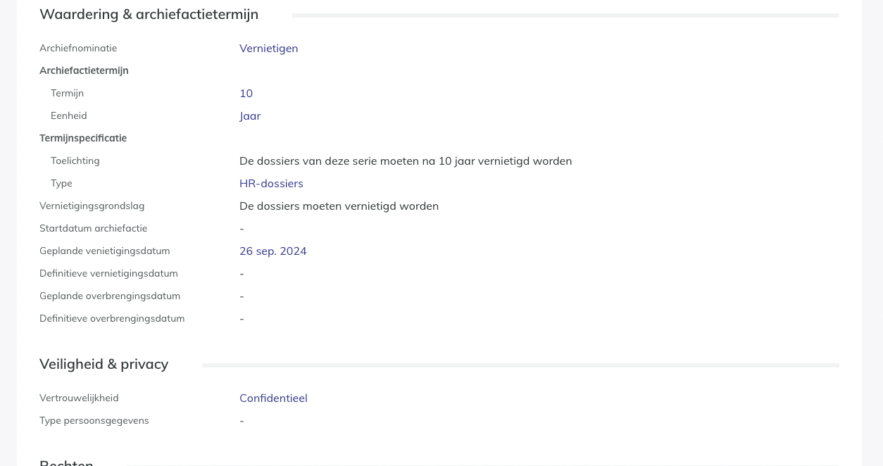The destruction process: an essential part within your information management

Our platform includes clear procedures and processes to manage information in a reliable and sustainable way. One such process is the destruction process, which uses our flexible metadata model to determine which objects qualify for destruction and when this should happen.
In the physical world, files to be destroyed are literally shredded and burned. But how does this process work in the digital world and what is its importance?
Why is digital destruction important?
Digital file destruction is important from several perspectives:
- Regulatory compliance: Many sectors are regulated by strict data retention and destruction laws, such as the GDPR (or AVG) in Europe. Proper data destruction prevents legal risks and fines. Data is sometimes required to be destroyed after a certain period of time or upon termination of a contract.
- Protection of confidential information: The destruction process ensures that confidential data cannot be accessed by unauthorised persons, which is an important part of protecting sensitive business information and personal data. This reduces the risk of data breaches, unlawful use of (personal) data and cybercrime.
- Cost savings: Deleting obsolete or unnecessary documents helps free up storage capacity within the software. This ensures more efficient data management and lower costs for storing unnecessary data. Potential savings are thus: hosting and management, licensing and maintenance, administrative burden, etc.
- Risk management: By destroying data at the right time, companies can minimise risks such as reputational damage, unlawful use of data and unnecessary legal complications.
- Better management of information: With a larger amount of information, it takes an employee much more effort and time to find the right information. By destroying information that no longer needs to be retained, and is therefore redundant, you have more control over your information.
For which sectors and applications could the destruction process be of interest?
In both the public and private sectors, this process is essential.
- In the Netherlands , for example, the destruction process at the Nationaal Archief Nederland plays a crucial role in the management of government information and documents. This process is carefully carried out according to the rules and regulations of Dutch archival legislation, with the aim of striking the right balance between preserving valuable historical documents and destroying redundant or obsolete data.
- For the Flemish Government, Zeticon implemented a custom destruction flow for Het Digitaal Archief, adapted to Flemish regulations.
- Healthcare: Destroying medical records in a secure manner to comply with privacy regulations (such as HIPAA in the US or AVG in the EU).
- Financial sector: Destruction of financial data to comply with legal retention periods and protect customer information.
- HR: Destroying old personnel files according to legal requirements to protect employee privacy.
Think also of applications such as Application retirement. You incur costs for licences and maintenance of information systems and backups containing digital information that should have been destroyed.
How does the destruction process work in our platform?
In our information management and archiving platform, predefined management rules can be set for medium- and long-term files and documents.
- A fully automated destruction process
Thanks to the flexible metadata model, management rules can be included in the metadata and relevant files and documents are destroyed through an automated process. Thanks to a smart plug-in that establishes the calculation rule, it is possible to set customer-specific dates when a document or file should be destroyed.
Upon destruction, our platform will automatically change the status of the objects on the scheduled destruction date and the representations (effective files) will be permanently removed from the system. However, the metadata will still be visible. - Full tracking of the destroyed file or document
The date on which this action is performed is included in the object's metadata so that one can see at any time when a document or object is no longer available. In addition, the justification for destruction is always kept in our platform.
- An evaluation flow for destruction
Moreover, it is possible to set whether the destruction of the document/file must be performed immediately according to the scheduled destruction date or whether the destruction may only be performed after user approval. This is useful in situations when, according to certain rules, several people must give their approval for destruction. In this way, you also build in an extra check so that information is not destroyed wrongly.
- A process based on each customer's needs and requirements
The destruction process is obviously different for each of our customers. Before we activate the destruction flow, we first sit down with our customers to discuss the desired flow and management rules in detail.

The difference between documents in archive phase and destruction phase
Last but not least, it is important to determine in advance which files and documents should be archived and which should be destroyed. Within Zeticon, we use the following definition:
- Archived objects: these are no longer relevant for publication (among the other objects), but still crucial to keep in storage.
- Objects to be destroyed: objects that no longer need to be kept in storage, nor are they available for consultation.
In our platform, we also provide the option of archiving objects instead of completely destroying them.
Conclusion
A well-designed destruction process within an archiving software solution is crucial to meet legal requirements, ensure confidentiality, optimise storage and reduce business risks. This is especially true in regulated sectors such as the public sector, healthcare, finance and legal services.